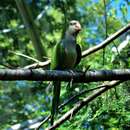en
names in breadcrumbs


Perception Channels: visual ; tactile ; acoustic ; chemical
The Quaker parrot is not currently under threat of endangerment. They are well adapted in most environments including locations of cold weather and snow.
US Migratory Bird Act: no special status
US Federal List: no special status
CITES: appendix ii
IUCN Red List of Threatened Species: least concern
According to a representative from the California Department of Agriculture, Quakers are considered a pest bird species. Quakers are illegal in California, under any circumstances, despite the lack of any documented evidence of crop destruction in the state by wild colonies of Quakers. Embassies, consulates and UN representatives of countries such as Argentina claim that the birds are pest species in their habitat, destroying as much as two-thirds of the grain crops planted each year (Higdon 1998).
They do not appear to cause significant problems in Chicago (South 1998).
There is a market for Quakers as pets. In captivity, mutations are prized. Unusual color mutations in pet quakers are highly valued and breeders strive to achieve them. In this way, breeders have been developed some parrot colors such as blue, yellow, cinnamon, pied, and albino. Such mutations are prized by many collectors, making them much more expensive than normal Quakers (Jordan 1997) .
Myiopsitta monachus has been observed to eat a variety of seeds, fruits, blossoms, insects, leaf buds, thistles, grasses and parts of trees. They consume an assortment of sunflower seeds, both black and stiped; safflower seeds, pumpkin seeds, and other smaller seeds. Near populated areas, the birds have also been known to eat sweet potatoes, legumes, drying meat, cereal crops, such as maize and sorghum, as well as citrus crops (Higdon 1998).
Monk parakeets, more commonly known as Quaker parrots, can be found near large water sources, and in the lowland areas of Paraguay, Bolivia, Argentina, and Brazil. They inhabit open savannas, scrub forests, and palm groves, especially where rainfall is low. They are also distributed in South American city parks, on farms, and in yards (Higdon 1998). In North America, escaped birds have established breeding colonies in Chicago and Miami and in the states of Alabama Connecticut, Delaware, Louisiana, New York, Oregon, Texas, and Virginia (South 1998).
Biogeographic Regions: neotropical (Native )
Myiopsitta monachus prefers open savannas, scrub forests, and palm groves (Higdon 1998). But because it is a highly adaptable species, the parrots readily take residence in eucalyptus trees. Quakers make their own nests by weaving sticks, twigs, small branches, and other materials into complex structures (Doane 1994).
Terrestrial Biomes: savanna or grassland ; scrub forest
Average lifespan
Status: captivity: 22.1 years.
A Quaker Parrot is a medium-sized bird, about 11 to 13 inches long from head to the tip of the long, tapered tail. The basic colors of the bird are green and gray. Adults of the nominate race, Myiopsitta monachus, have a blue-gray forehead. The lores, cheeks, and throat are pale gray. Feathers on the throat and abdomen are edged in a lighter gray, giving them a scalloped, barred look. Feathers below the abdomen are olive green, becoming yellowish green on the lower abdomen, legs and under the tail. The beak is a light pinkish-brown color, and the legs are gray. The eyes are brown. Males and females are not sexually dimorphic (Greeson 1995).
Other Physical Features: endothermic ; bilateral symmetry
Average mass: 81.7 g.
Average basal metabolic rate: 0.5189 W.
Reproduction of the Quaker parrot begins in late August and continues until Novemeber. Groups of wild Quakers live together, each pair with its own residence comprising of [at] least two chambers. Each compartment serves a different purpose, including one for egg incubation or a place to feed young chicks, another in which to feed older chicks, and a third from which parents can keep a watch for danger (Higdon 1998). Each clutch of eggs ranges from four to seven eggs. Incubation lasts approximately twenty days.
Key Reproductive Features: iteroparous ; gonochoric/gonochoristic/dioecious (sexes separate); sexual ; oviparous
Average time to hatching: 31 days.
Average eggs per season: 7.